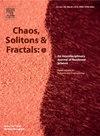Enhanced scaling crossover detection in long-range correlated time series
Q1 Mathematics
引用次数: 0
Abstract
Various time series, such as biological signals and stock prices, exhibit long-range correlations and a fractal nature characterized by the power-law scaling in the low-frequency range of the power spectrum. Instead of the power spectral analysis, scaling analysis methods such as Detrended Fluctuation Analysis (DFA) and Detrending Moving-Average Analysis (DMA) have been employed to estimate the scaling exponent. Scaling analysis results often uncover crossover phenomena, highlighting two distinct scaling regions—a short- and a long-range exponent. Estimating the two respective scaling exponents and the crossover point is crucial, as they can provide insight into different underlying mechanisms or dynamics operating at various scales. However, DFA and DMA with higher-order detrending tend to distort the time scales, and methods for accurately estimating the crossover have not been thoroughly investigated. This study addresses scale distortions in higher-order DFA and DMA by leveraging the relationship between the fluctuation function and the power spectrum of time series. We propose a method for crossover estimation using the Savitzky–Golay differentiation filter. Applying this method to numerical experiments with an autoregressive process exhibiting crossovers demonstrated that our proposed technique estimates crossovers more accurately than conventional segmented regression approaches used in DFA and DMA. We applied the proposed scaling crossover estimation method to the time series of the postural center of pressure (CoP), showcasing its practical applications in studying long-range correlations in empirical time series.
长程相关时间序列的增强尺度交叉检测
各种时间序列,如生物信号和股票价格,表现出长期相关性和分形性质,其特征是功率谱低频范围内的幂律缩放。用非趋势波动分析(DFA)和非趋势移动平均分析(DMA)等标度分析方法代替功率谱分析来估计标度指数。标度分析结果经常揭示交叉现象,突出两个不同的标度区域-短期指数和长期指数。估计两个各自的缩放指数和交叉点是至关重要的,因为它们可以深入了解在不同尺度上运行的不同潜在机制或动态。然而,具有高阶去趋势的DFA和DMA往往会扭曲时间尺度,准确估计交叉的方法尚未得到充分研究。本研究利用波动函数与时间序列功率谱之间的关系来解决高阶DFA和DMA的尺度扭曲问题。我们提出了一种使用Savitzky-Golay微分滤波器的交叉估计方法。将该方法应用于显示交叉的自回归过程的数值实验表明,我们提出的技术比DFA和DMA中使用的传统分段回归方法更准确地估计交叉。将所提出的尺度交叉估计方法应用于体位压力中心(CoP)时间序列,展示了该方法在研究经验时间序列中远程相关性方面的实际应用。
本文章由计算机程序翻译,如有差异,请以英文原文为准。
求助全文
约1分钟内获得全文
求助全文
来源期刊

Chaos, Solitons and Fractals: X
Mathematics-Mathematics (all)
CiteScore
5.00
自引率
0.00%
发文量
15
审稿时长
20 weeks
 求助内容:
求助内容: 应助结果提醒方式:
应助结果提醒方式:


